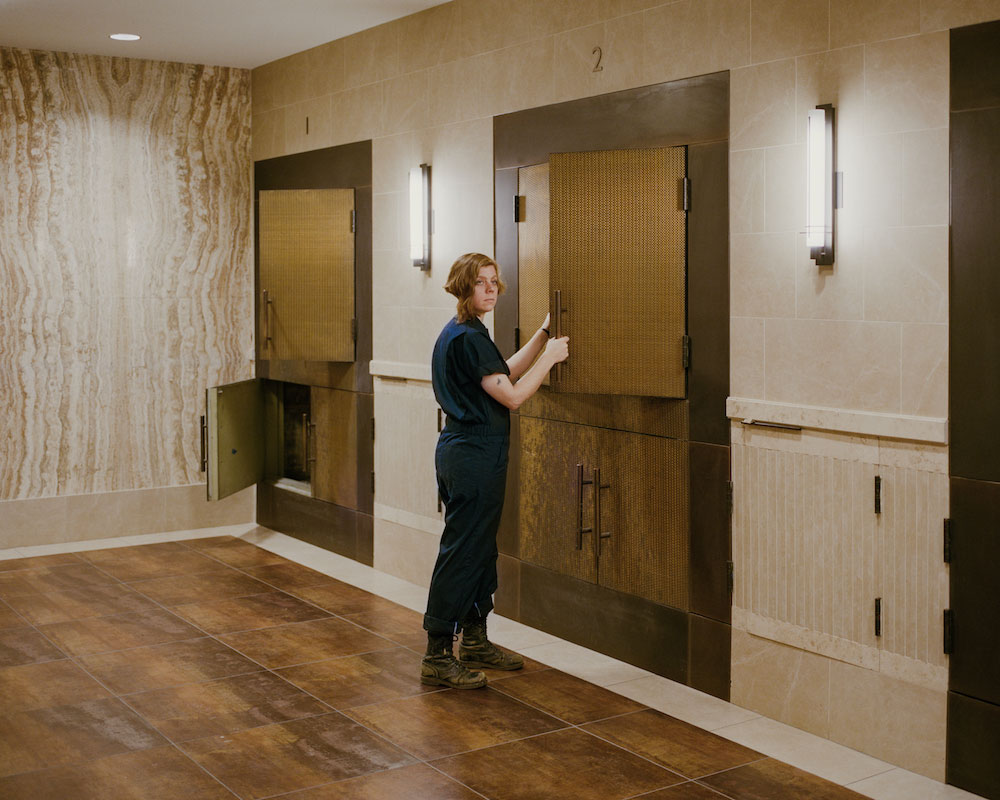About
Patterns of Transformation: Designing Sex, Death, and Survival in the 21st Century is a design reference for creating intimate social gatherings and experiences that offer the potential for human enrichment and transformation.
My name is Ida Benedetto, and for the past 10+ years I have been helping people gain new insight through adventure and play. You can find out more about me on my website. If you’re like to collaborate or have me give a talk, get in touch: [email protected].
-

Ida at the Green-wood crematory in Brooklyn, New York.
Unpublished Businessweek photo by Daniel Shea.
Email List
Received. Thank you!
The Backstory
Starting in 2012, I created intimate adventures in and around New York City, including one night escapades at abandoned regional resorts, a photo safari in a defunct sugar refinery, a concert with no audience on an abandoned observation deck, and most famously, a speakeasy in a dry water tower accessible only by invitation. I did this through a design practice I co-founded, first called Wanderlust Project, and then Sextantworks.
Eventually, we were inundated by requests from onlookers who wanted in. They’d send eager emails asking how to be added to the list, as if pitching themselves to us would gain them admission to some secret society. Each request broke my heart a little. We publicized our exploits in the hopes of inspiring others to make their own daring rituals of transgression and transformation. Instead, people looked to us to do it for them.
I began to suspect that we took for granted whatever it was we were doing right. Our guests consistently went farther and deeper than we could have anticipated, emerging awestruck and grateful. Maybe our experiences weren’t as natural to replicate as I thought. All this sent me on a quest to distill what exactly makes an intimate social gathering truly transformative.
Only recently, an important question came up: In seeking out transformative, but emotionally demanding experiences like sex parties, funerals, and wilderness trips, what was it that I was trying to turn toward? As I set Sextantworks in motion, the very creative practice that provoked my inquiry came apart under the weight of its own success. My co-founder and I parted ways over conflicting ambitions, and nothing I knew how to stand on wanted to hold me up anymore. Somewhat unwittingly, under the guise of doing research, I was seeking out places to fall apart and people to put me back together again. Thankfully, I found what I was looking for.
Making This Better
Patterns of Transformation is a work in progress, apparent from the version number next to the title on the home page. I’ll issue updates to make the resource increasingly relevant and accessible.
I hope you will help. Does something here bring to mind a powerful gathering where everything happened just right? Or maybe you had to struggle through an important experience that was rather poorly designed? If you’re an experience designer yourself, maybe you found a useful solution to a problem you’ve faced, or perhaps you have a bone to pick with me about the recommendations I make. Whatever it is, I’d love to hear from you.
There is an opportunity to share your thoughts at the bottom of almost every page. You’re also welcome to get in touch by email. If you just want to hear about new adventures and updates, head back up the page to join the email list.
On the Title & Illustrations
The project’s title is a reference to the 1977 book A Pattern Language by Christopher Alexander, Sara Ishikawa, and Murray Silverstein.
In the introduction, they write:
The fact is, that we have written this book as a first step in the society-wide process by which people will gradually become conscious of their own pattern languages, and work to improve them. We believe… that the languages which people have today are so brutal, and so fragmented, that most people no longer have any language to speak of at all—and what they do have is not based on human, or natural considerations.
They were writing about architecture and urban design, but I feel the same way about social gatherings and ritual experiences today.
The conch shells found around the site are used to symbolize transformation. Lovely and organic, the conch can be used to project sound as a trumpet, or capture the sound of the sea. You can use it to call people together, or to listen to something too big to ever actually be contained. This is what transformation has felt like for me.
Thank You
Many people helped make this possible.
From The Design Research Program at the School of Visual Arts:
Molly Heintz, Alice Twemlow, Pierre Alexandre de Looz, Adam Harrison Levy
From NEW INC:
Julia Kaganskiy, Eli Kuslansky, Bruce Nussbaum, and Rasu Jilani
Interviewees:
Mr. Gentleman, Larisa Fuchs, AR, Kelsey, Amy Cunningham, Caitlin Doughty, Pamela, Elizabeth, Nicolina Art, Leslie Appling, Donna Ford, Annie Morita, Alex Saxon, Randy Boyd, Tate Higgins, Tom Boettcher, Gerben Scherpbier, Athena Aicher, John Law, Matt Adams, Chazz Levi, Frank Rose
Friends and generous readers:
Tiffany Kuan, Christian Howard, Lois Beckett, Kaitlyn Ellison, Sean McIntyre, Scott Leinweber, Daniel Wenger, Yelena Rachitsky, Sarah Besky, Gary Chou, Casey Gollan, Christina Xu, Anne Libby, Brendan Schlagel, Ivan Askwith, Alex Villarino, Adam Lucas, Taeyoon Choi, Gaelen Green
Illustrations: Lilli Carré
© 2017 - 2021 Ida Benedetto. All Rights Reserved.